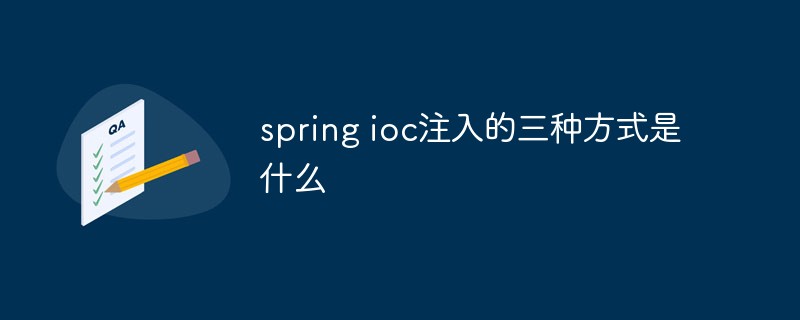Quelles sont les trois méthodes d'injection de ressort IOC ?
- 青灯夜游original
- 2021-02-04 17:47:5717560parcourir
Les trois méthodes d'injection Spring Ioc sont : 1. Injection de la méthode Setter Une fois que le conteneur a instancié le bean en appelant le constructeur sans paramètre ou la méthode d'usine statique sans paramètre, il appelle la méthode setter du bean. 2. Injection de méthode constructeur. 3. Injection d'espace de noms P.

L'environnement d'exploitation de ce tutoriel : système windows7, version java8, ordinateur Dell G3.
Spring IOC (trois méthodes d'injection de dépendances) :
1. >L'injection de méthode Setter se produit lorsque le conteneur instancie un bean en appelant le constructeur sans paramètre ou la méthode d'usine statique sans paramètre, puis appelle la méthode setter du bean, qui implémente l'injection de dépendances basée sur le setter.
package com.jpeony.spring.setter;
import com.jpeony.spring.common.HelloServiceImpl;public class HelloWord {
private HelloService helloService;
// setter方式注入Bean
public void setHelloService(HelloService helloService) {
this.helloService = helloService;
}
@Override
public void selfIntroduction() {
// 向大家打招呼
helloService.sayHello("大家好!");
}
}rrree
2. Injection de constructeur L'injection de dépendances de constructeur est implémentée en déclenchant le constructeur d'une classe via le conteneur, qui a une série de Paramètres, chaque paramètre représente une dépendance vis-à-vis d'autres classes.
<?xml version="1.0" encoding="UTF-8"?>
<beans xmlns="http://www.springframework.org/schema/beans"
xmlns:xsi="http://www.w3.org/2001/XMLSchema-instance"
xsi:schemaLocation="http://www.springframework.org/schema/beans http://www.springframework.org/schema/beans/spring-beans.xsd">
<!--
Bean声明:
该bean类似于javaConfig中的@Bean注解;
用于创建bean的类通过class属性来指定,并且需要使用全限定的类名。
通过id指定bean的ID。如果不显示指定,默认使用class的全限定名进行命名。
eg:
com.jpeony.spring.common.HelloServiceImpl#0,其#0是一个计数器的形式,
用来区分相同类型的其他bean。
使用自动化命名很方便,但是没有多少实际用处,还是建议自己给bean显示设定ID。
-->
<bean id="helloService" class="com.jpeony.spring.common.HelloServiceImpl"/>
<!-- setter注入bean -->
<bean id="HelloWord" class="com.jpeony.spring.setter.HelloWord">
<property name="helloService" ref="helloService"/>
</bean>
</beans>package com.jpeony.spring.setter;
import com.jpeony.spring.common.HelloServiceImpl;
public class HelloWord {
private HelloService helloService;
// 构造方法注入
public HelloWord (HelloService helloService) {
this.helloService = helloService;
}
}
3. Injection d'espace de noms P <?xml version="1.0" encoding="UTF-8"?>
<beans xmlns="http://www.springframework.org/schema/beans"
xmlns:xsi="http://www.w3.org/2001/XMLSchema-instance"
xsi:schemaLocation="http://www.springframework.org/schema/beans http://www.springframework.org/schema/beans/spring-beans.xsd">
<!--
Bean声明:
该bean类似于javaConfig中的@Bean注解;
用于创建bean的类通过class属性来指定,并且需要使用全限定的类名。
通过id指定bean的ID。如果不显示指定,默认使用class的全限定名进行命名。
eg:
com.jpeony.spring.common.HelloServiceImpl#0,其#0是一个计数器的形式,
用来区分相同类型的其他bean。
使用自动化命名很方便,但是没有多少实际用处,还是建议自己给bean显示设定ID。
-->
<bean id="helloService" class="com.jpeony.spring.common.HelloServiceImpl"/>
<!-- 构造方法注入bean -->
<bean id="HelloWord" class="com.jpeony.spring.setter.HelloWord">
<constructor-arg><ref bean="helloService"/></constructor-arg>
</bean>
</beans>package com.jpeony.spring.setter;
import com.jpeony.spring.common.HelloServiceImpl;
public class HelloWord {
//名字
private String name;
//年龄
private String age;
//方法类
private HelloService helloService;
public void setName (String name) {
this.name = name;
}
public void setAge (String age) {
this.age = age;
}
public void setHelloService(HelloService helloService) {
this.helloService = helloService;
}
@Override
public void selfIntroduction() {
// 向大家打招呼
helloService.sayHello("我叫"+ name + ",今年" + age + "岁,大家好!");
}
}
Injection de balise P dans le bean de collection<?xml version="1.0" encoding="UTF-8"?>
<beans xmlns="http://www.springframework.org/schema/beans"
xmlns:xsi="http://www.w3.org/2001/XMLSchema-instance"
<!-- 引入p命名标签 -->
xmlns:p="http://www.springframework.org/schema/p"
xsi:schemaLocation="http://www.springframework.org/schema/beans http://www.springframework.org/schema/beans/spring-beans.xsd">
<bean id="helloService" class="com.jpeony.spring.common.HelloServiceImpl"/>
<!-- p标签注入bean -->
<bean id="HelloWord" class="com.jpeony.spring.setter.HelloWord"
p:name="明明" p:age="24" p:helloService-ref="helloService"></bean>
</beans>rrreePour plus de connaissances sur la programmation informatique, veuillez visiter :
Ce qui précède est le contenu détaillé de. pour plus d'informations, suivez d'autres articles connexes sur le site Web de PHP en chinois!

